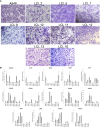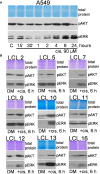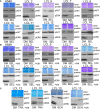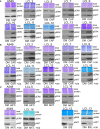Crosstalk between protein kinases AKT and ERK1/2 in human lung tumor-derived cell models
- PMID: 36686779
- PMCID: PMC9848735
- DOI: 10.3389/fonc.2022.1045521
Crosstalk between protein kinases AKT and ERK1/2 in human lung tumor-derived cell models
Abstract
There is no doubt that cell signaling manipulation is a key strategy for anticancer therapy. Furthermore, cell state determines drug response. Thus, establishing the relationship between cell state and therapeutic sensitivity is essential for the development of cancer therapies. In the era of personalized medicine, the use of patient-derived ex vivo cell models is a promising approach in the translation of key research findings into clinics. Here, we were focused on the non-oncogene dependencies of cell resistance to anticancer treatments. Signaling-related mechanisms of response to inhibitors of MEK/ERK and PI3K/AKT pathways (regulators of key cellular functions) were investigated using a panel of patients' lung tumor-derived cell lines with various stemness- and EMT-related markers, varying degrees of ERK1/2 and AKT phosphorylation, and response to anticancer treatment. The study of interactions between kinases was the goal of our research. Although MEK/ERK and PI3K/AKT interactions are thought to be cell line-specific, where oncogenic mutations have a decisive role, we demonstrated negative feedback loops between MEK/ERK and PI3K/AKT signaling pathways in all cell lines studied, regardless of genotype and phenotype differences. Our work showed that various and distinct inhibitors of ERK signaling - selumetinib, trametinib, and SCH772984 - increased AKT phosphorylation, and conversely, inhibitors of AKT - capivasertib, idelalisib, and AKT inhibitor VIII - increased ERK phosphorylation in both control and cisplatin-treated cells. Interaction between kinases, however, was dependent on cellular state. The feedback between ERK and AKT was attenuated by the focal adhesion kinase inhibitor PF573228, and in cells grown in suspension, showing the possible role of extracellular contacts in the regulation of crosstalk between kinases. Moreover, studies have shown that the interplay between MEK/ERK and PI3K/AKT signaling pathways may be dependent on the strength of the chemotherapeutic stimulus. The study highlights the importance of spatial location of the cells and the strength of the treatment during anticancer therapy.
Keywords: AKT; ERK (extracellular signal-regulated kinase); cancer cell; cell signaling; cellular resistance; kinase inhibitors; lung cancer; targeted drugs.
Copyright © 2023 Stulpinas, Sereika, Vitkeviciene, Imbrasaite, Krestnikova and Kalvelyte.
Conflict of interest statement
The authors declare that the research was conducted in the absence of any commercial or financial relationships that could be construed as a potential conflict of interest.
Figures









Similar articles
-
Impact of oncogenic driver mutations on feedback between the PI3K and MEK pathways in cancer cells.Biosci Rep. 2012 Aug;32(4):413-22. doi: 10.1042/BSR20120050. Biosci Rep. 2012. PMID: 22668349 Free PMC article.
-
Integrin β1, myosin light chain kinase and myosin IIA are required for activation of PI3K-AKT signaling following MEK inhibition in metastatic triple negative breast cancer.Oncotarget. 2016 Sep 27;7(39):63466-63487. doi: 10.18632/oncotarget.11525. Oncotarget. 2016. PMID: 27563827 Free PMC article.
-
PI3K pathway is involved in ERK signaling cascade activation by histamine H2R agonist in HEK293T cells.Biochim Biophys Acta. 2016 Sep;1860(9):1998-2007. doi: 10.1016/j.bbagen.2016.06.016. Epub 2016 Jun 15. Biochim Biophys Acta. 2016. PMID: 27316323
-
PI3K/Akt/mTOR and Ras/Raf/MEK/ERK signaling pathways inhibitors as anticancer agents: Structural and pharmacological perspectives.Eur J Med Chem. 2016 Feb 15;109:314-41. doi: 10.1016/j.ejmech.2016.01.012. Epub 2016 Jan 12. Eur J Med Chem. 2016. PMID: 26807863 Review.
-
Targeting ERK1/2 protein-serine/threonine kinases in human cancers.Pharmacol Res. 2019 Apr;142:151-168. doi: 10.1016/j.phrs.2019.01.039. Epub 2019 Feb 20. Pharmacol Res. 2019. PMID: 30794926 Review.
Cited by
-
FGFR1 overexpression promotes resistance to PI3K inhibitor alpelisib in luminal breast cancer cells through receptor tyrosine kinase signaling-mediated activation of the estrogen receptor.Cancer Drug Resist. 2025 May 28;8:24. doi: 10.20517/cdr.2024.181. eCollection 2025. Cancer Drug Resist. 2025. PMID: 40510030 Free PMC article.
-
In-depth insight into tumor-infiltrating stromal cells linked to tertiary lymphoid structures and their prospective function in cancer immunotherapy.Exp Hematol Oncol. 2025 Aug 10;14(1):105. doi: 10.1186/s40164-025-00695-8. Exp Hematol Oncol. 2025. PMID: 40784879 Free PMC article. Review.
-
Combination of Everolimus and Bortezomib Inhibits the Growth and Metastasis of Bone and Soft Tissue Sarcomas via JNK/p38/ERK MAPK and AKT Pathways.Cancers (Basel). 2023 Apr 26;15(9):2468. doi: 10.3390/cancers15092468. Cancers (Basel). 2023. PMID: 37173935 Free PMC article.
-
The Role and Efficacy of JNK Inhibition in Inducing Lung Cancer Cell Death Depend on the Concentration of Cisplatin.ACS Omega. 2024 Jun 18;9(26):28311-28322. doi: 10.1021/acsomega.4c01950. eCollection 2024 Jul 2. ACS Omega. 2024. PMID: 38973918 Free PMC article.
-
Combining AdipoRon with Paclitaxel Unveils Synergistic Potential in Non-Small Cell Lung Cancer Cells via AMPK-ERK1/2 Signaling.Cells. 2025 Apr 16;14(8):602. doi: 10.3390/cells14080602. Cells. 2025. PMID: 40277927 Free PMC article.
References
-
- Stulpinas A, Imbrasaitė A, Krestnikova N, Valerija Kalvelytė A. Recent approaches encompassing the phenotypic cell heterogeneity for anticancer drug efficacy evaluation. In: Tumor progression and metastasis. London, UK: IntechOpen; (2020). doi: 10.5772/intechopen.89395 - DOI
LinkOut - more resources
Full Text Sources
Miscellaneous

